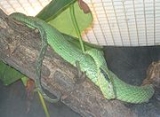
Bothriechis bicolor
Encyclopedia
- Common names: Guatemalan palm-pitviper, Guatemalan tree viper.
Bothriechis bicolor is a venomous
Venomous snake
"Poisonous snake" redirects here. For true poisonous snakes, see Rhabdophis.Venomous snakes are snakes which have venom glands and specialized teeth for the injection of venom...
pitviper
Crotalinae
The Crotalinae, commonly known as "pit vipers" or crotaline snakes, are a subfamily of venomous vipers found in Asia and the Americas. They are distinguished by the presence of a heat-sensing pit organ located between the eye and the nostril on either side of the head...
species
Species
In biology, a species is one of the basic units of biological classification and a taxonomic rank. A species is often defined as a group of organisms capable of interbreeding and producing fertile offspring. While in many cases this definition is adequate, more precise or differing measures are...
found in southern Mexico
Mexico
The United Mexican States , commonly known as Mexico , is a federal constitutional republic in North America. It is bordered on the north by the United States; on the south and west by the Pacific Ocean; on the southeast by Guatemala, Belize, and the Caribbean Sea; and on the east by the Gulf of...
and Guatemala
Guatemala
Guatemala is a country in Central America bordered by Mexico to the north and west, the Pacific Ocean to the southwest, Belize to the northeast, the Caribbean to the east, and Honduras and El Salvador to the southeast...
. The specific name refers to the contrasting ventral and dorsal colors. No subspecies
Subspecies
Subspecies in biological classification, is either a taxonomic rank subordinate to species, ora taxonomic unit in that rank . A subspecies cannot be recognized in isolation: a species will either be recognized as having no subspecies at all or two or more, never just one...
are currently recognized.
Description
Adults are usually 60-70 cm in length, but may reach 100 cm, and the body is relatively slender.The color pattern consists of a green or bluish green ground color. Usually this is without any pattern, but sometimes specimens from Mexico
Mexico
The United Mexican States , commonly known as Mexico , is a federal constitutional republic in North America. It is bordered on the north by the United States; on the south and west by the Pacific Ocean; on the southeast by Guatemala, Belize, and the Caribbean Sea; and on the east by the Gulf of...
have black flecks and dots and/or blue blotches. The dorsum of the head is a uniform green without any postocular stripe. The interstitial skin is often blue, which can also be true for the borders of some scales. The belly has a somewhat lighter color, usually a uniform yellowish-green.
Geographic range
Found along the Pacific versant from southeastern ChiapasChiapas
Chiapas officially Estado Libre y Soberano de Chiapas is one of the 31 states that, with the Federal District, comprise the 32 Federal Entities of Mexico. It is divided in 118 municipalities and its capital city is Tuxtla Gutierrez. Other important cites in Chiapas include San Cristóbal de las...
in Mexico
Mexico
The United Mexican States , commonly known as Mexico , is a federal constitutional republic in North America. It is bordered on the north by the United States; on the south and west by the Pacific Ocean; on the southeast by Guatemala, Belize, and the Caribbean Sea; and on the east by the Gulf of...
, east to south-central Guatemala
Guatemala
Guatemala is a country in Central America bordered by Mexico to the north and west, the Pacific Ocean to the southwest, Belize to the northeast, the Caribbean to the east, and Honduras and El Salvador to the southeast...
. Also known from a few locations in Honduras
Honduras
Honduras is a republic in Central America. It was previously known as Spanish Honduras to differentiate it from British Honduras, which became the modern-day state of Belize...
in the southern part of the Sierra del Merendón
Sierra del Merendón
Sierra del Merendón is a mountain range extending on the eastern border of Guatemala and Honduras. Its south-western border is marked by the Lempa River valley, its northern border by the Motagua River valley...
and the Cerro Santa Bárbara. The type locality given is "Des forêts de Saint-Augustine, département de Solola (Guatémala), sur le versant occidental de la Cordillèra. 610 mètres d'altitude" [= Forests of St. [San] Augustín, on western slope of the Cordillera, Department of Sololá, Guatemala, 610 m]. Actually, San Augustín is on the southern slope of Volcán Atitlán.
Conservation status
This species is classified as Least Concern (LC) on the IUCNWorld Conservation Union
The International Union for Conservation of Nature and Natural Resources is an international organization dedicated to finding "pragmatic solutions to our most pressing environment and development challenges." The organization publishes the IUCN Red List, compiling information from a network of...
Red List of Threatened Species
IUCN Red List
The IUCN Red List of Threatened Species , founded in 1963, is the world's most comprehensive inventory of the global conservation status of biological species. The International Union for Conservation of Nature is the world's main authority on the conservation status of species...
(v3.1, 2001). Species are listed as such due to their wide distribution, presumed large population, or because it is unlikely to be declining fast enough to qualify for listing in a more threatened category. The population trend is stable. Year assessed: 2007.
External links
- Bothriechis bicolor at Greg Lasley Nature Photography. Accessed 8 September 2007.

